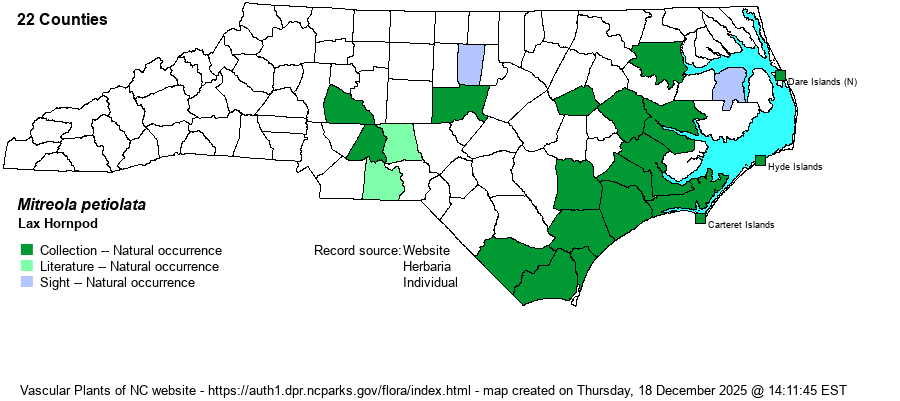| Author | (J.F. Gmelin) Torrey & A. Gray | |
| Distribution | Present over the eastern and southeastern Coastal Plain, with records north to Bertie, Tyrrell, and Dare counties; probably present to the VA line. A few scattered record for the eastern and central Piedmont, but none for the Sandhills.
This is a Southeastern species, found only north to southeastern VA and OK, and south to the Gulf Coast. | |
| Abundance | Infrequent to fairly common in the lower Coastal Plain. Very rare in the east-central Piedmont. | |
| Habitat | This is a wetland species of somewhat rich soils, found in swamps, ditches, wet thickets, and marsh edges. It can occur in wet meadows in the Piedmont. It occurs in muddier and richer soils than the similar M. sessilifolia. | |
| Phenology | Blooms from July to September, and fruits from September to frost. | |
| Identification | This is an erect herb growing to about 1-1.5 feet tall, with a few branches. It has several pairs of opposite leaves, each being ovate to lanceolate-ovate and about 2.5 inches long and 1-inch wide, with entire margins and a very short petiole. This species has numerous small spike-like cymes growing from mid- and upper leaf axils and branch tips, each one being about 1.5-2 inches long, each with 10 or more tiny, white, 5-lobed corollas, secund (all on one side) on each cyme, and often somewhat curved. As the flowers are so tiny, barely 1/10-inch long, it is the effect of the numerous white "spikes", often curved, and the typical ovate leaves that distinguish this species. M. sessilifolia has almost rounded and very short leaves and a nearly unbranched stem, giving a very narrow look as opposed to a broader look to M. petiolata. Though neither of these two species is truly common, a little bit of field work in the lower Coastal Plain in late summer into fall will turn up these at some point. | |
| Taxonomic Comments | Formerly the species in the genus Mitreola were placed in the genus Cynoctonum; this was named as C. mitreola.
| |
| Other Common Name(s) | Caribbean Miterwort. Most references, especially older ones, use "miterwort" as the common name for this genus. However, more recent references are now using "hornpod" for the group name. "Miterwort" is the name given to Mitella -- named as "Twoleaf Miterwort", a plant in the saxifrage family. | |
| State Rank | S3 | |
| Global Rank | G5 | |
| State Status | | |
| US Status | | |
| USACE-agcp | FACW link |
| USACE-emp | FACW link |

